Limnofregata Hasegawai on:
[Wikipedia]
[Google]
[Amazon]
''Limnofregata'' ("Freshwater frigatebird") is an
 The Eocene frigatebird genus ''Limnofregata'' comprises birds whose fossil remains were recovered from prehistoric freshwater environments, unlike the marine preferences of their modern-day relatives. They are thought to have lived like gulls of the genus ''Larus''. They inhabited the freshwater or brackish lakes that in time formed in today's
The Eocene frigatebird genus ''Limnofregata'' comprises birds whose fossil remains were recovered from prehistoric freshwater environments, unlike the marine preferences of their modern-day relatives. They are thought to have lived like gulls of the genus ''Larus''. They inhabited the freshwater or brackish lakes that in time formed in today's
PDF fulltext
{{Taxonbar, from=Q961985 Bird genera Fregatidae Eocene birds of North America Fossil taxa described in 1977
extinct
Extinction is the termination of a kind of organism or of a group of kinds (taxon), usually a species. The moment of extinction is generally considered to be the death of the last individual of the species, although the capacity to breed and ...
genus of primitive frigatebird. The two known species were described after fossils from the Early Eocene Green River Formation (c.49 million years ago) of Wyoming. A number of good complete and partial skeletons, some with feather impressions, are known of the type
Type may refer to:
Science and technology Computing
* Typing, producing text via a keyboard, typewriter, etc.
* Data type, collection of values used for computations.
* File type
* TYPE (DOS command), a command to display contents of a file.
* Ty ...
species, ''Limnofregata azygosternon'', and ''L. hasegawai'' is known from two skulls and most of one torso.
Description
Birds of the genus ''Limnofregata'' resembled modern frigatebirds, but had shorter less-hooked bills and longer legs, and longer slitlike nasal openings. They stood tall when on the ground and had a wingspan of about . The beak was shorter than that of modern frigatebirds, and lacked the typical hook at the end, resembling a strongbooby
A booby is a seabird in the genus ''Sula'', part of the family Sulidae. Boobies are closely related to the gannets (''Morus''), which were formerly included in ''Sula''.
Systematics and evolution
The genus ''Sula'' was introduced by the Frenc ...
beak more than that of today's frigatebirds. The species differ conspicuously in size, with ''L. hasegawai'' being as much larger when compared to ''L. azygosternon'' as today's largest species of frigatebird (''Fregata magnificens
The magnificent frigatebird (''Fregata magnificens'') is a seabird of the frigatebird family Fregatidae. With a length of and wingspan of it is the largest species of frigatebird. It occurs over tropical and subtropical waters off America, betw ...
'') is compared to the smallest extant one ('' Fregata ariel''). The bill of ''L. hasegawai'' was notably larger still than that of its congener, whereas its feet were smaller, echoing a pattern found in the extant '' Fregata'' species.
In 2014, a third species, ''Limnofregata hutchisoni'', was described from the Wasatch Formation, 2 million years older than the Green River Formation. Though the only remains are a coracoid and a humerus, these bones clearly identify it as part of the genus. It is of comparable size to ''F. magnificens''. It is at least 53 and possibly 54 or 55 million years old. The fossil beds have remains of crocodiles, large trionychid turtles and fish, indicating a sizeable body of water.
Paleobiology
 The Eocene frigatebird genus ''Limnofregata'' comprises birds whose fossil remains were recovered from prehistoric freshwater environments, unlike the marine preferences of their modern-day relatives. They are thought to have lived like gulls of the genus ''Larus''. They inhabited the freshwater or brackish lakes that in time formed in today's
The Eocene frigatebird genus ''Limnofregata'' comprises birds whose fossil remains were recovered from prehistoric freshwater environments, unlike the marine preferences of their modern-day relatives. They are thought to have lived like gulls of the genus ''Larus''. They inhabited the freshwater or brackish lakes that in time formed in today's Green River Green River may refer to:
Rivers
Canada
*Green River (British Columbia), a tributary of the Lillooet River
*Green River, a tributary of the Saint John River, also known by its French name of Rivière Verte
*Green River (Ontario), a tributary of ...
valley due to the uplift of the Rocky Mountains, feeding on smaller vertebrates and probably harassing other shorebirds for food and feasting on dead fish (e.g. '' Knightia'') during summer dieoffs due to oxygen depletion
Hypoxia refers to low oxygen conditions. Normally, 20.9% of the gas in the atmosphere is oxygen. The partial pressure of oxygen in the atmosphere is 20.9% of the total barometric pressure. In water, oxygen levels are much lower, approximately 7 p ...
in the eutrophic lakes. Modern frigatebirds show pronounced sexual dimorphism in size, apparently to avoid competition due to different soaring
Soaring may refer to:
* Gliding, in which pilots fly unpowered aircraft known as gliders or sailplanes
* Lift (soaring), a meteorological phenomenon used as an energy source by some aircraft and birds
* ''Soaring'' (magazine), a magazine produced ...
behavior of male and female wings. As ''Limnofregata'' was most likely not a soaring bird, it can be expected that the sexes were much alike. It is not known if the males had a prominent throat balloon for advertising for mates as in their modern relatives, but ''Limnofregata'' throat bones differ markedly from those of modern frigatebirds.
References
* Olson, Storrs L. & Matsuoka, Hiroshige (2005): New specimens of the early Eocene frigatebird ''Limnofregata'' (Pelecaniformes: Fregatidae), with the description of a new species. ''Zootaxa'' 1046: 1–15PDF fulltext
{{Taxonbar, from=Q961985 Bird genera Fregatidae Eocene birds of North America Fossil taxa described in 1977